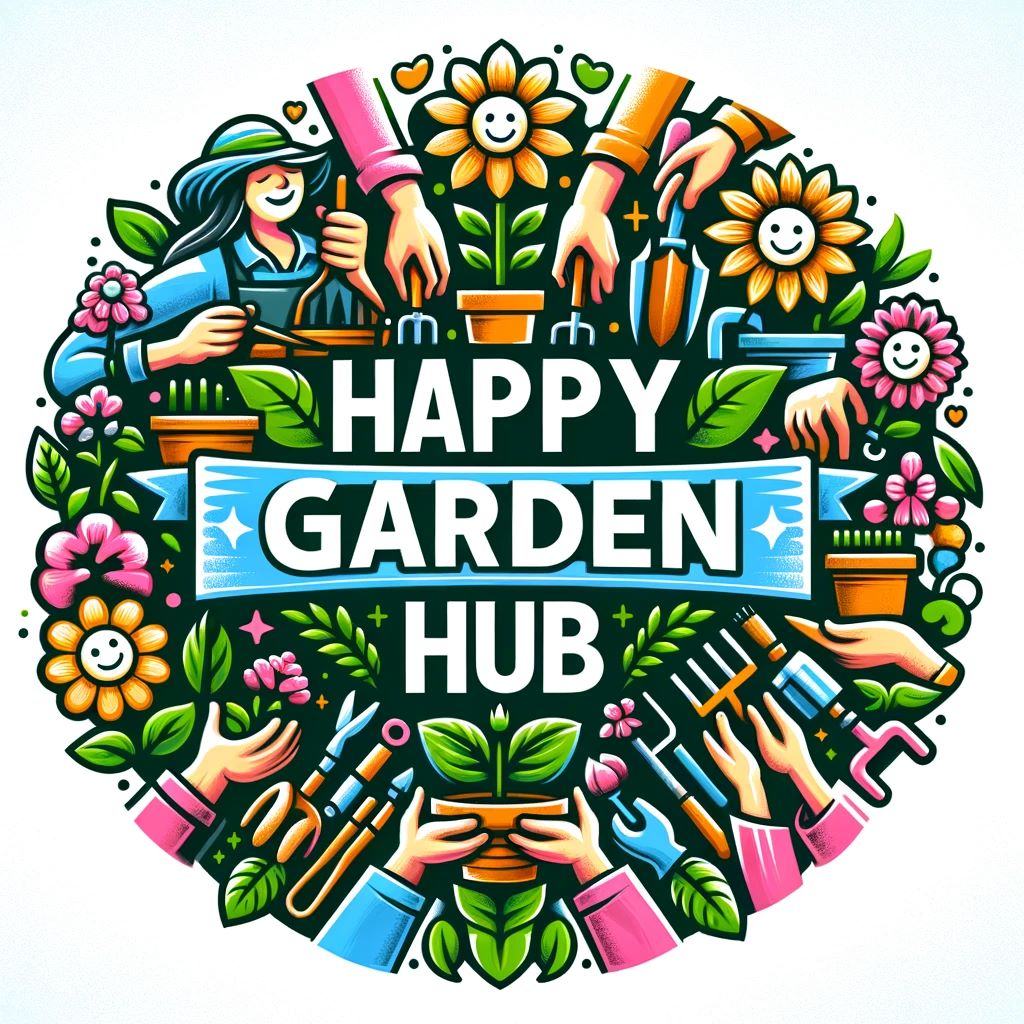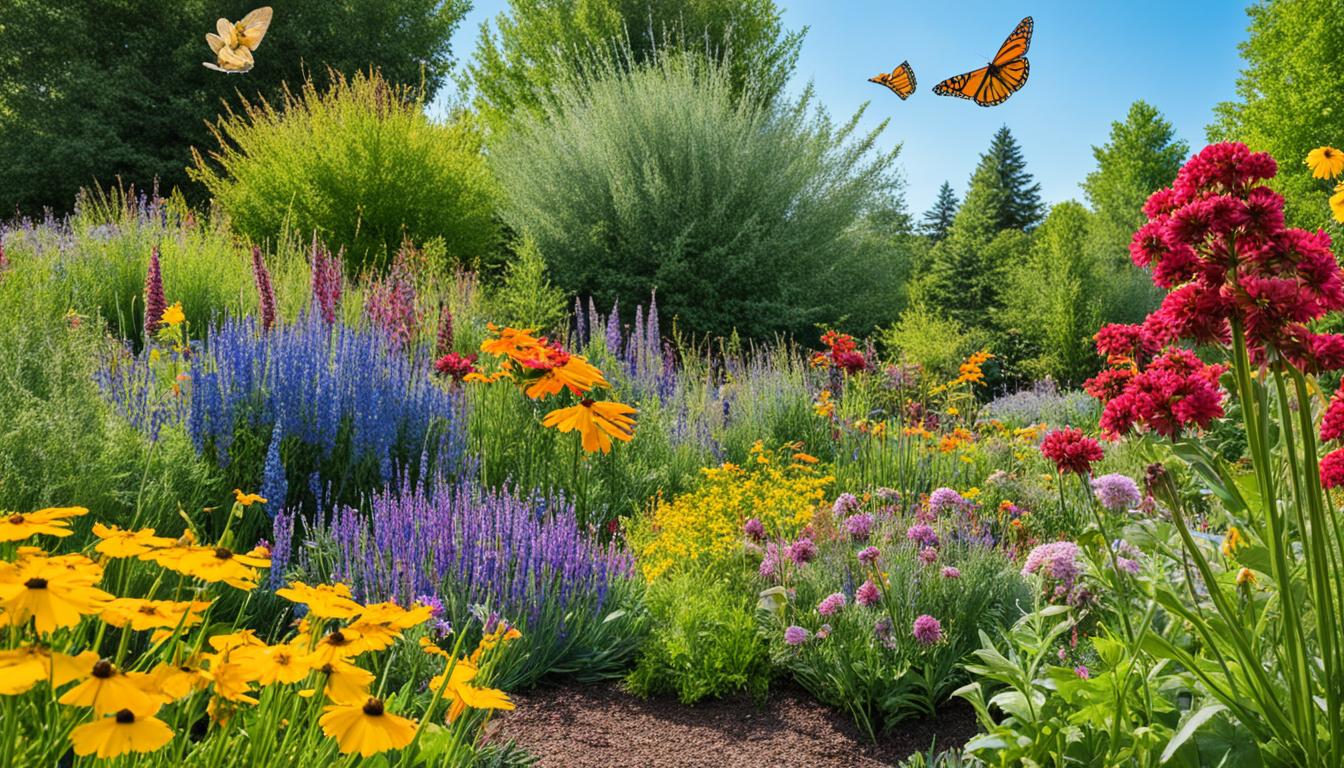This post contains affiliate links.
Do you remember the first time a butterfly landed on a flower in your garden? That moment was magical, right? Imagine turning your garden into a place where these beautiful creatures thrive. You can make your garden a vibrant spot that’s good for the environment and your senses.
Your garden can be more than just a pretty spot. It can be a place full of life, buzzing with bees, fluttering with butterflies, and singing with birds. By learning how to attract these creatures, you help them and make your garden more colorful and lively.
Did you know a single bee colony can pollinate 300 million flowers every day? Or that hummingbirds visit up to 2,000 flowers a day, eating half their body weight in nectar and insects? These facts show how important pollinators are to our world. By using native plants, you’re helping these hardworking creatures and making your garden beautiful.
Let’s start making your garden a dream spot for pollinators. We’ll look at how to attract them, from picking the right plants to creating cozy homes. Get ready to see nature’s magic in your own backyard!
Key Takeaways
- Pollinators are key to garden health and plant growth
- Using native plants is best for local pollinators
- Diverse plants meet different pollinator needs
- Safe habitats and water are crucial for pollinators
- Using pesticides wisely protects pollinators
- Planting in groups helps pollinators forage better
- Knowing pollinator behavior improves garden design
The Importance of Pollinators in Your Garden
Pollinators are key to a healthy and beautiful garden. They help plants reproduce and keep the ecosystem balanced. Creating pollinator gardens is essential for your garden’s well-being.
Why bees, butterflies, and birds matter
Bees, butterflies, and birds are nature’s helpers. They pollinate nearly 80% of the world’s crops. Without them, your garden would lack life. These creatures make sure your flowering shrubs and plants reproduce, keeping your garden lively every year.
The role of pollinators in plant reproduction
Pollinators act as matchmakers for plants. They move pollen from one flower to another. This helps plants produce seeds and fruits, which is vital for your garden’s health.
“Native plants are 4 times more attractive to native pollinators than non-natives.”
Benefits for your garden ecosystem
Creating spaces with butterfly bushes and other flowers helps pollinators and your garden. These creatures boost crop yields, support biodiversity, and control pests naturally.
- Improved fruit and vegetable production
- Enhanced flower blooms throughout the season
- Natural pest control
- Increased biodiversity in your garden
A garden that supports pollinators benefits you too. So, start planning your pollinator paradise today!
Creating a Pollinator-Friendly Garden Layout
Are you ready to turn your yard into a haven for bees, butterflies, and birds? Start by choosing a sunny spot that’s safe from strong winds. Pollinators like to eat without getting blown away.
Think of your garden as a buffet. Plant native flowers in groups of three to five. This makes it easy for pollinators to find food. Add plants of different heights for a feast that offers both food and shelter.
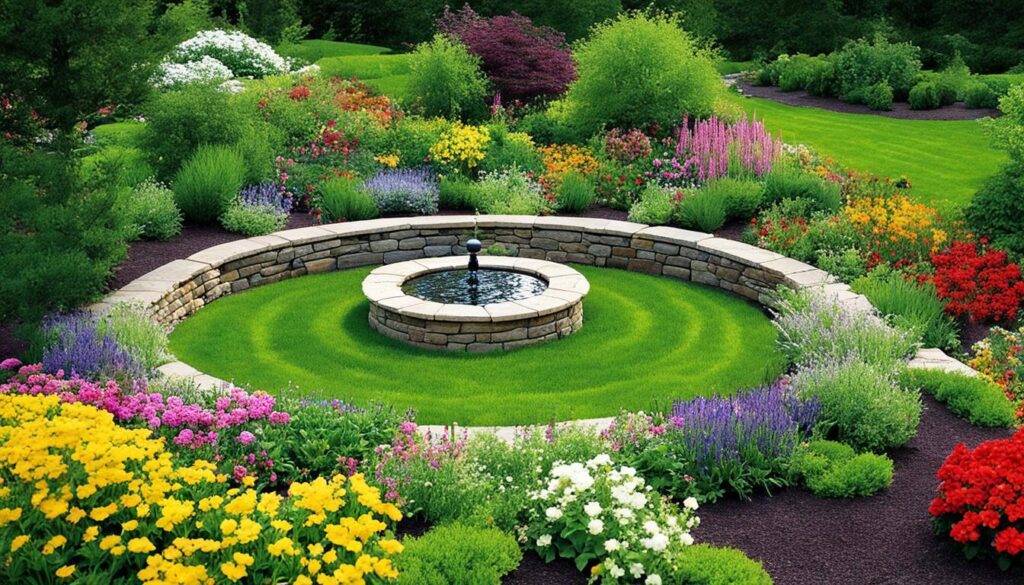
Make your garden exciting with a mix of annuals, perennials, and edibles. Choose plants that bloom at different times for a feast all year round. This way, you’ll always have something beautiful to see, no matter the season.
Add special treats like butterfly bushes for those fluttering guests. Plant milkweed for monarch butterflies or dill for black swallowtails. These plants are like VIP areas for pollinators.
| Garden Feature | Purpose | Example Plants |
|---|---|---|
| Sunny Areas | Attract sun-loving pollinators | Sunflowers, Lavender |
| Windbreaks | Protect pollinators from strong winds | Hedges, Tall Grasses |
| Wildflower Meadows | Provide diverse nectar sources | Coneflowers, Black-eyed Susans |
| Butterfly Bushes | Attract and nourish butterflies | Buddleia, Lantana |
Follow these tips to make your garden a paradise for pollinators. Your garden will be alive with activity. You’ll have the best insect spot in town, right next to the wildflower meadows!
How to Attract Bees, Butterflies, and Birds
Creating a garden that buzzes with life isn’t just about pretty flowers. It’s about making a home for bees, butterflies, and birds. Let’s explore how to draw these important visitors to your garden.
Understanding Pollinator Preferences
Pollinators have their favorites. Bees love blue, purple, and yellow flowers. Butterflies are drawn to reds and purples. Birds prefer flowers in red and orange shapes. It’s like a color-coded buffet for them!
Choosing the Right Plants
Native plants are key. They’ve grown with local pollinators, making them perfect matches. Use Penstemon for bees, Milkweed for butterflies, and Bee Balm for hummingbirds. Plant them together – it’s like welcoming your guests with open arms.
Creating Diverse Habitats
Offer a variety of options for pollinators:
- Sunny spots with flat rocks for butterflies to bask
- Patches of bare soil for ground-nesting bees
- Dense shrubs for birds to hide and nest
- Water features for all to sip and splash
Don’t forget about bird feeders – they’re like fast food joints for our feathered friends!
| Pollinator | Favorite Colors | Preferred Plants |
|---|---|---|
| Bees | Blue, Purple, Yellow | Lavender, Sunflower |
| Butterflies | Red, Purple | Butterfly Weed, Aster |
| Birds | Red, Orange | Cardinal Flower, Trumpet Honeysuckle |
A pollinator-friendly garden is a living ecosystem. By offering food, water, and shelter, you’re giving them a home. So, get ready and start planting!
Essential Plants for Attracting Bees
Want to make your garden a hit with bees? Attracting bees is key to drawing bees, butterflies, and birds to your garden. Let’s dive into some bee-friendly plants that’ll make your garden buzz!
Native Plants for Bee-Friendly Gardens
Native plants are the stars of bee-friendly gardens. They’re like the local food for bees – familiar, tasty, and always wanted. Top picks include coneflowers, black-eyed Susans, and asters. These plants are not just pretty; they’re bee magnets!
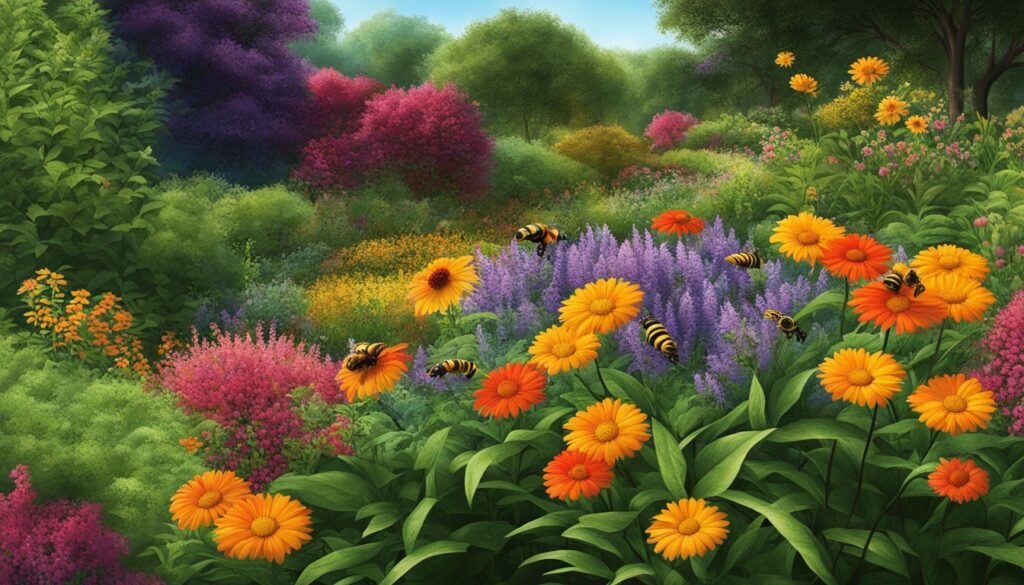
Herbs and Flowers That Bees Love
Bees adore certain herbs and flowers. Lavender thrives in sunny spots with dry soil and is a bee favorite. Hardy geraniums are easy to grow and irresistible to bees. And don’t forget about monarda, also known as bee balm – it’s a 5-star restaurant for bees!
Creating a Year-Round Bee Buffet
To keep bees coming back, offer a diverse menu all year. Mix it up with plants like:
- English Ivy for autumn attraction
- Foxgloves for shade and sun
- Verbena bonariensis for summer-long nectar
- Dianthus for June to October blooms
Bees love vibrant colors like purple, blue, and yellow. By planting a mix of native plants and flowering shrubs, you’ll have a year-round bee buffet. This keeps your garden buzzing with life!
| Plant | Blooming Period | Preferred Conditions |
|---|---|---|
| Lavender | Summer | Sunny, dry soil |
| English Ivy | Autumn | Versatile |
| Hardy Geraniums | Spring-Summer | Sun to partial shade |
| Monarda (Bee Balm) | Summer | Full sun, well-drained soil |
Butterfly-Attracting Plants and Features
Creating a butterfly garden is a great way to help these beautiful pollinators. With the right plants and features, you’ll soon have a garden full of butterflies.
Butterfly bushes are key for any butterfly garden. These shrubs have fragrant flowers that butterflies love. Plant them in a sunny spot to enjoy the colorful visitors.
Wildflower meadows are also great for butterflies. They offer many nectar sources and host plants for caterpillars. Native plants are best because they work well with local butterflies.
Here are tips to make your garden butterfly-friendly:
- Plant flowers in various shapes and colors that bloom at different times
- Add milkweed to help monarch butterflies
- Put in shallow water sources for butterflies to drink from
- Keep some wild areas in your garden
Here’s a list of butterfly-attracting wildflowers for your garden:
| Flower Name | Package Size | Seed Count | Price |
|---|---|---|---|
| Texas Paintbrush | 18mg | ~350 | $2.95 |
| Cherry Brandy Rudbeckia | 18mg | ~20 | $3.95 |
| Cherokee Sunset Mix Rudbeckia | 14mg | ~25 | $3.95 |
| Common Black-Eyed Susan | 25mg | 100+ | $2.95 |
By adding these plants and features, you’ll make a garden that’s beautiful and supports butterflies. It will be a place that looks great and helps pollinators.
Bird-Friendly Garden Elements
Ready to turn your garden into a bird paradise? Let’s explore the key elements that’ll attract birds quickly. These tips will make your yard a hit with feathered friends!
Plants that attract birds
Native plants are a great way to draw birds to your garden. They offer food and help local wildlife. Add shrubs, trees, and flowers that have berries, seeds, and nectar all year. Birds will love visiting your garden!
Bird feeders and baths
Set up bird feeders to be the talk of the town. Make sure they’re at least ten feet from trees to keep birds safe. Don’t forget a birdbath for a bird spa day! Keep the water shallow and change it often for freshness.
Nesting boxes and shelters
Provide nesting boxes for birds to call home. Put them in hidden spots with nearby perches. It’s like giving them a bird condo! Creating gardens for birds beautifies your yard and helps local ecosystems.
| Garden Element | Purpose | Maintenance Tips |
|---|---|---|
| Native Plants | Provide food and shelter | Choose variety for year-round blooms |
| Bird Feeders | Supplement natural food sources | Clean weekly to prevent disease |
| Birdbaths | Offer fresh water | Change water regularly, add heater in winter |
| Nesting Boxes | Provide safe breeding spots | Clean out annually after breeding season |
With these bird-friendly elements, your backyard will become a lively, bird-filled oasis. Enjoy your bird-watching adventures!
Water Features for Pollinators
Want to make your garden a buzz with life? Add water features to attract bees, butterflies, and birds. These additions are not only beautiful but also vital for pollinators. Learn how to create a thirst-quenching oasis for pollinators.
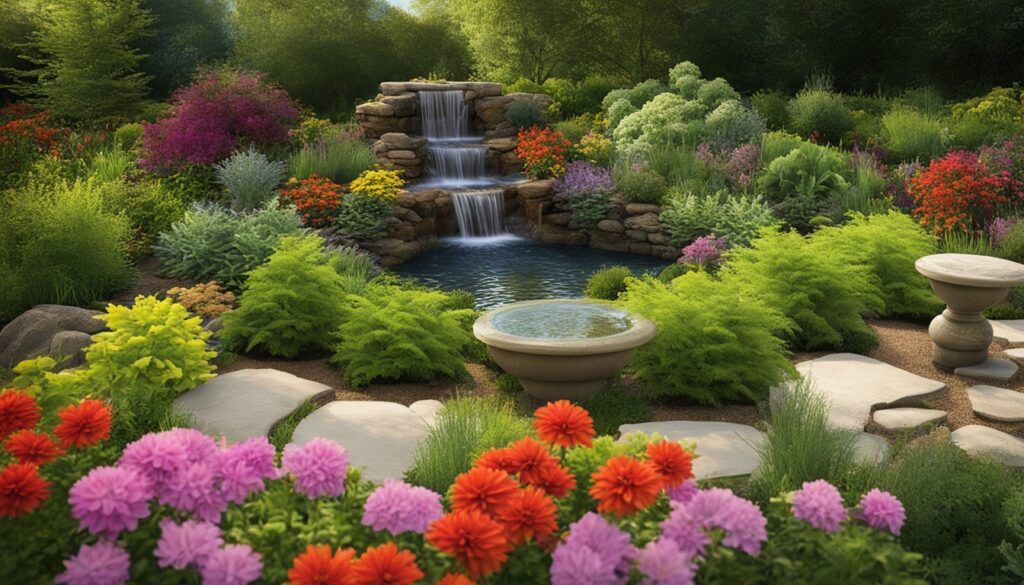
Start with shallow water sources. Birdbaths, saucers, or mud puddles work well. For hummingbirds, a bubbling fountain is perfect.
Choose safe spots for your water features, away from predators. This ensures your garden visitors can drink and play safely.
“If you’re thirsty, they’re thirsty too!”
Try Bee Cups for your garden. They look like flowers and are great for bees. Add solar fountains and Nature Oasis products for more variety.
Keeping your water sources clean is important. Change the water every 2-3 days to avoid mosquitoes.
| Water Feature | Best For | Maintenance |
|---|---|---|
| Shallow Saucers | Bees, Butterflies | Daily refill |
| Birdbaths | Birds | Clean every 2-3 days |
| Bubbling Fountains | Hummingbirds | Weekly cleaning |
Adding water features brings more than just beauty to your garden. It creates a home for pollinators. So, make a splash in your garden design!
Creating Safe Havens: Shelter and Nesting Sites
Ready to make your garden a home for wildlife? Let’s create cozy spots for our buzzing, fluttering, and chirping friends! Offering nesting spots is like giving nature’s tiny travelers a five-star stay.
Insect hotels and bee houses
Think of insect hotels as mini skyscrapers for bugs! Place these nesting boxes 6-7 feet off the ground in sunny spots. Mason bees will pollinate your garden well if you provide these homes. Also, leave some bare soil for ground-nesting bees – they like the earthy feel!
Butterfly boxes and resting spots
Butterflies also need a place to rest! Put butterfly bushes and boxes in your garden’s sheltered corners. These safe spots will attract butterflies, adding magic to your garden. Remember, different butterflies like different plants, so mix them up!
Bird houses and nesting materials
Want to hear birds singing in your garden? Install birdhouses in hidden spots with nearby branches. Add nesting materials like twigs, grass clippings, and pet hair around your yard. Soon, you’ll see feathered families moving in! With these cozy spots, your garden will become a sanctuary for many creatures.
FAQ
Why are pollinators important for gardens?
What makes a garden pollinator-friendly?
How do I choose the right plants for bees?
What plants attract butterflies?
How can I attract more birds to my garden?
What are some water feature options for pollinators?
How can I provide shelter and nesting sites?
This post contains affiliate links.
